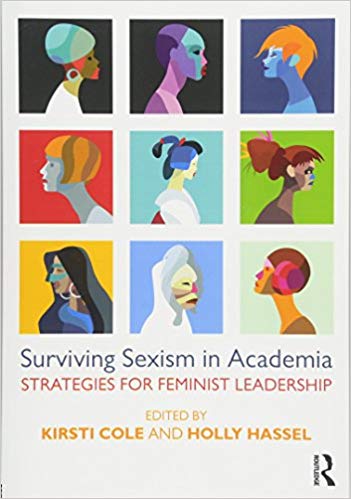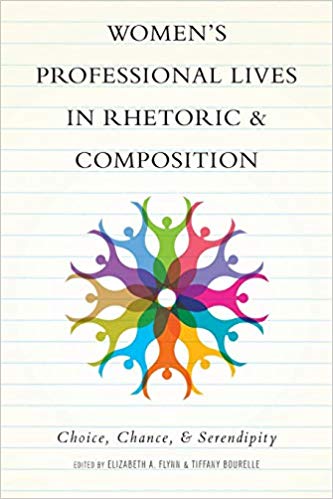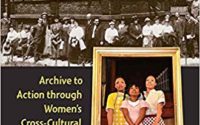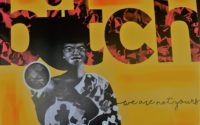Book Review: Cole & Hassel’s Surviving Sexism and Flynn & Bourelle’s Women’s Professional Lives
Cole, Kirsti and Holly Hassel, eds. Surviving Sexism in Academia: Strategies for Feminist Leadership. Routledge, 2017.
Flynn, Elizabeth A. and Tiffany Bourelle, eds. Women’s Professional Lives in Rhetoric and Composition: Choice, Chance, & Serendipity. Ohio State UP, 2018.
While sexism is a backdrop for diverse women’s professional narratives in Elizabeth A. Flynn and Tiffany Bourelle’s collection Women’s Professional Lives in Rhetoric and Composition, Kirsti Cole and Holly Hassel’s edited collection, Surviving Sexism in Academia, brings sexism uncompromisingly into the foreground as contributors define, explore and strategize responses to sexism in higher education. I’m deeply appreciative of both of these collections, and I have already recommended each to colleagues within and beyond my institution. Women’s Professional Lives helps me reflect on the affordances of my actions as a professional, whether that refers to giving up tenure at one institution for a more collegial department at another or identifying with a principle of integrity over spinelessness in my administrative work. Surviving Sexism offers myriad strategies women of all ethnicities/races (Daufin 57) and our allies might use personally and collaboratively to identify and challenge sexism in concrete ways — whether through Susan Diab’s creative vision of making an academic gown to explore some of the intellectual vulnerabilities institutionalized sexism buttresses, Heather Hill-Vásquez and Laurie Ann Britt-Smith’s smart critique of Lean In’s “faux feminism” (39), or Fran Sepler’s necessary identification of the ways women bully other women in the workplace. Reading these two collections side by side reinforces the fact that women’s professional careers (in rhetoric and composition in particular and academia in general) are always shaped by sexism, and that women are resilient and creative in our responses to professional challenges.
Both collections value narrative as a research method and demonstrate a value of diversity and an understanding of intersectionality, yet they are quite different in scope and approach. Flynn and Bourelle’s collection extends Elizabeth A. Flynn, Patricia Sotirin and Ann Brady’s theorizing of resilience in Feminist Rhetorical Resilience into fifteen chapters that narrate different women’s reflections on the ways chance, choice and serendipity have shaped their professional lives in rhetoric and composition. Flynn and Bourelle describe the intent of the narratives they have gathered as illustrations of career experiences to guide other scholars (3). I expect scholars early in their careers or at a crossroads can use this edited collection to help them imagine possible futures, while women settled into their careers or close to retirement may find this collection spurs reflection on choices they’ve made and paths they’ve taken. The articles offer diversity in class, race, gender identification, location and rank through contributors’ multiple identifications. Narratives by senior scholars like Malea Powell, Jacqueline Rhodes and Shirley Rose sit alongside equally engaging contributions by more junior scholars, like Iklim Goskel and Natasha N. Jones, and independent scholars or scholars not on the tenure track, like Beth L. Hewett and Irene Papoulis. There is also considerable range in how authors discuss the book’s key words: choice, chance and serendipity.
Because there simply isn’t the space to talk about each chapter across the two collections, I briefly sketch out some of the themes and lines of inquiry these texts explore while referencing some illustrative chapters. The introduction to Flynn and Bourelle’s collection is particularly excellent in laying out their argument for the book; the coeditors effectively theorize their key concepts and explain how interactions between agency, choices and chances are at play in the ways – to invoke Gerda Lerner — we live our lives and tell our stories. I especially appreciate how the coeditors discuss agency in light of new materialism and the limits and possibilities of agentive action. Most notably, some scholars focus on the deliberateness of their choices and others acknowledge that they see the shape of their choices only in hindsight, in composing their narratives. In Chapter 3, “My Kairotic Career,” Anne Ruggles Gere talks about how personal choices, like “spend[ing] my life with a supportive feminist, parenting in an interracial and variously abled family, and having the freedom to move across the country and back” (56), shaped her professional life as a scholar-teacher. In Chapter 8, “Word by Word, Bead by Bead: Making a Scholarly Life,” Malea Powell talks about the stops and starts, risks and rewards, twists and turns of making choices, some more agentive than others. Powell invites readers to join her in considering our own choices and makings, particularly in relationship to the land and the history of the colonization of indigenous peoples (136). In Chapter 14, “Empowerment through Change and Resilience: A Technical Communicator’s Tale,” Natasha N. Jones’s discussion of “the stereotypes about black, single mothers and the challenges I would face because of the gendered and racialized perceptions that are entrenched in our society” locates choice within the constraints of racism and sexism (222). Jones actively turns her response to these damaging stereotypes into possibility by harnessing her agency as a mother and as a technical communications scholar and professor to support social justice and empower her students.
Serendipity, “the willingness to act on hunches or trust one’s own intuition – to learn from one’s experience” (5), is also a guiding term in Women’s Professional Lives in Rhetoric and Composition. Attention to serendipity invites readers to consider how kinesthetic or emotional ways of knowing shape careers. In Chapter 6, “Choreography: Running Away, Moving Toward, Living In,” Suellynn Duffey describes her dance of life and career as one fashioned by a “combination of opportunity, improvisation, desperation, and resilience rather than consciously designed, but nonetheless deliberate and agentive” (91). “Kinesthetic elegance” rather than rational thought has guided her life path (89). In Chapter 13, “My Life in Composition Studies: Serendipity, Shame, Status Anxiety, and Trusting My Instincts,” lecturer Irene Papoulis describes how following hunches and gut instincts helped her “emerge from the gloom of my status anxiety” (216). It’s compelling to think about how cultivating an awareness of intuition might guide our career paths. Ultimately, I find the collection thought-provoking and encouraging, not because these diverse women’s paths are marked by ease or privilege, but because these women persist on their own terms, making new paths when they came to dead ends and taking advantage of unexpected opportunities and encounters to pursue careers of their own making.
Cole and Hassel’s interdisciplinary edited collection, comprised of an ambitious thirty-one chapters with a summative infographic, documents the challenge of sexism as it shapes and constrains women’s leadership paths in academia. The collection places narrative and autoethnography alongside more traditional academic research methods using surveys, interviews or textual analysis, in fields ranging from rhetoric and composition to geography, philosophy and social work. In doing so, they achieve an impressive range of methods and scholarly voices, though the quality of articles is somewhat uneven. The discussions of mentoring, mothering and microaggressions are among the most robust themes. Likewise, coalition-building, policy creation/change and self-reflection emerge as important means for disrupting sexism. Some chapters invite further study because they rely on either a narrow scope of interviews, a single anecdote or site – generally a need to deepen or broaden the research. Still, the possibilities for uptake across the collection are significant, particularly when so many complex issues are represented and when the need to address sexism in academia is so great. I would like to see Cole and Hassel’s book used as a resource by department chairs, program leaders and upper administrators, so that they better understand the many faces of sexism in academia and learn specific strategies to mitigate bullying, recognize microaggressions and support mother-academics and other caregivers through changes in policy and cultural practices.
Surviving Sexism is organized into two sections with the chapters further organized into subsections; the layout is clear and the titles are explicit for guiding readers interested in particular topics. As the editors describe, Section One, Mapping the Challenges, “give[s] an overview of the ongoing challenges faced by women in academia, identifying the far-ranging, institutional, structural, and ideological barriers that shape women’s experience as academics as they move into leadership positions” (xxi). Section One includes three subsections: Dis/Locations, Disciplinary Contexts and Embodied Gender. Chapters that stood out to me across this section challenge us to find better language for referring to “women of color,” recognize different disciplinary manifestations of sexism, and reflect on ways white colleagues can better support women of all ethnicities/races when they share their experiences of microaggressions. In Chapter Six, “The Problem with the Phrase ‘Women and Minorities’: Racism and Sexism Intersectionality for Black Women Faculty,” E-K. Daufin effectively draws attention to the white supremacist patriarchal beliefs embedded in the phrase “women and minorities.” Daufin argues that “White women and minority people/people of color” or “women of all ethnicities/races and men of color” are more “accurate” and “intersectional” phrases that better reflect African American women’s faculty experiences (57). In Chapter Eight, “For the Love of the Feminist Killjoy: Solving Philosophy’s Woman White Male Problem,” Melissa M. Kazma and Jeanine Weekes Schroer reframe philosophy’s “woman problem” as a white male problem and develop strategies for changing subtle and hostile sexism in philosophy departments, including “embracing the feminist killjoy, rejecting the culture of justification, and focusing efforts and resources on problem-solving action (instead of discourse and defense)” (85). In the final section of Part I, in “On the Edge of Knowing: Microaggression and Epistemic Uncertainly as a Woman Scholar,” Saba Fatima examines gender, race and knowledge in her experiences with microaggressions. While Fatima writes that “senior women and people of color” typically affirm her experiential knowledge, white people appeal to rational forms of knowledge to discount her personal experiences and felt emotions (149). Fatima closes by offering four points that are especially useful for white leaders to learn to better support faculty and staff who share their experiences of microaggressions.
While Section One includes many options for acting against sexism in academia, as in Fatima’s chapter, Section Two, Feminist Strategies for Action, draws further attention to prospects for change and action through its two subsections: Changing Material Conditions and Changing Ideologies. In Chapter 21, “Motherhood and Leadership in Academia: Getting Beyond Survival Mode” Diane M. Hodge discusses how she uses her leadership position to make change: “making my own grassroots changes, modeling those changes for other department heads, and documenting the results of what it means to provide feminist leadership and a supportive academic environment to mothers” (210). In Chapter 27, “Rhetorics of Interruption: Navigating Sexism in the Academy,” coauthors Elise Verzosa Hurley, Amanda Wray and Erica Cirillo-McCarthy use Nedra Reynolds’s theorizing of interruption to guide their robust survey of 355 faculty, staff and administrators to better understand how interruption works “as a means of enacting change in academic professional contexts” (259). In chapter 29, “Reembodying the Positionality of MiddleMAN Administrators in Higher Education,” Bre Garrett, Aurora Matzke and Sherry Rankins-Robertson examine how “embodied delivery” affects their leadership positions as writing program administrators. They ultimately offer kairotic interventions, attention to embodied time and feminist leadership collaboration as advantageous embodied actions for women leaders (285).
In learning from women’s narratives, we might better reflect on and craft our own stories and gain productive insight into others’ lives. In reading research on sexism in academia, we gain an invaluable resource for naming and addressing many manifestations of sexism. We need to study and use these texts, and write our own, to gain insight into the experiences of diverse women’s lives and work and to help us make academia more equitable and more humane. I am completing this review in the days following Professor Christine Blasey Ford’s brave testimony of her high school experience of sexual assault by Brett Kavanaugh. Watching white cis gender male Republican senators close ranks around Judge Kavanaugh to protect their white male privilege underscores the fact that we live in a time and place where dominant narratives tell us women’s experiences don’t matter. Taken together, these collections value women’s lives and show that the work happening in academia to challenge sexism in all its insidious and explicit forms is both daunting and necessary — and it is happening.
KEYWORDS: women, sexism, academia, agency, narrative






 Kathleen J. Ryan is an associate professor of rhetoric and writing at Montana State University. She is a coeditor of Rethinking Ethos: A Feminist Ecological Approach to Rhetoric, a coauthor of GenAdmin: Theorizing WPA Identities in the Twenty-First Century, and coeditor of Walking and Talking Feminist Rhetorics: Landmark Essays and Controversies. In addition, she has articles in a range of writing and rhetoric journals on feminist rhetorics and writing program administration.
Kathleen J. Ryan is an associate professor of rhetoric and writing at Montana State University. She is a coeditor of Rethinking Ethos: A Feminist Ecological Approach to Rhetoric, a coauthor of GenAdmin: Theorizing WPA Identities in the Twenty-First Century, and coeditor of Walking and Talking Feminist Rhetorics: Landmark Essays and Controversies. In addition, she has articles in a range of writing and rhetoric journals on feminist rhetorics and writing program administration.